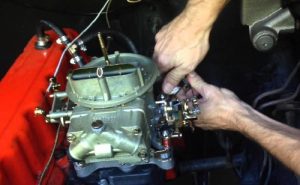
The carburetor is the heart and the lungs of any engine. It’s where your fuel and air mix, and deliver the cocktail to the intake manifold to fuel the engine.
Getting things right in the carburetor is crucial to the best running of any engine, and if you have a 350 Chevy under the hood, you want to feed it just right.
The remarkable thing is that there’s no one golden way to become the top carburetor supplier for the Chevy 350 – the replacement carburetor market is a very broad church.
Edelbrock, for instance, started out in Torrance in 1938, and has always pushed for the best quality available – to the point where it has its own R&D department and two forges, to be sure it gets things dead on.
Jet Performance Products on the other hand is just hitting its 50th anniversary, having started life as an engine building and carburetor shop for Southern California drag racers, even running its own cars in NHRA and IHRA – and setting records in three different classes. Transferring to electronic testing, the company still has a proud racing tradition, but has now gone high-tech in its outlook.
Meanwhile Holley has been driving the development of fuel-system technology for over a century, innovating almost constantly and now the company produces market-leading EFI products and brands.
Although they’re just three of the best manufacturers on the market, the different stories and routes of these three players shows the vibrancy, the evolution, and the readiness of the performance replacement part market to take on the challenges of the 21st century.
Best Carburetor For 350 Chevy Reviews 2025
| Image | Model | Speciality | Price |
|---|---|---|---|
 |
Edelbrock 1406 Performer 600 CFM Square Bore Carburetor | Best Overall | Check on Amazon |
 |
Jet 35002 Rochester Quadrajet Stage 2 Carburetor | Runners Up | Check on Amazon |
 |
Holley 0-1850sa Aluminum 600 CFM Four-Barrel Street Carburetor | Budget Option | Check on Amazon |
Key Criteria – How we tested and compared these products
When comparing the merits of different carburetors of the Chevy 350, we took a handful of elements into account.
Venturi
The venturi is one of the most important elements of the carburetor. It regulates the amount of air that can flow into the carburetor and out to the cylinders of the engine. But more importantly, it gives speed to the airflow as it enters the inlet.
It does this by the merit of its shape – the venturi is the section near the inlet of the tube that expands outwards to form a narrower space in the air passageway. Performance of the venturi can distinguish a world-beating carburetor from a merely average one.
Choke Valves
The choke controls the amount of air entering the inlet. There are two types of chokes – electric and manual. Electric chokes are generally more efficient than manual ones, offering better regulation all year round.
Carburetors with chokes draw air in with greater regularity.
CFM Calculation
CFM, or cubic feet per minute, is a value of how much air will flow in through the main Venturi. It’s made up of values for the volume of air circulated by the engine’s pistons in cubic inches, multiplied by the maximum number of revolutions per minute in the cylinders, and then divided by 3456.
The CFM of a good carburetor will be at a balance. If it’s too high, you’ll get low RPM, and if it’s too high, it will stop the engine delivering the power of which it’s capable.
Size
Size is important when it comes to carburetors. The bigger they are, the more air and fuel they can pull in, to deliver better efficiency in the mix. Essentially, the bigger the carburetor, the more power will be going to the Chevy 350.
But.
While a bigger carburetor will give you maximum horsepower, it will also compromise performance on the low and mid-range RPM. In other words, the more air on start-up, the less likely the engine is to be able to deliver it. If the carburetor is too small, you’re going to have the opposite problem. So we’re always looking for a Goldilocks carburetor as we test.
Intake Manifold Vacuum
The manifold vacuum acts as the veins of the system, feeding the mixture of fuel and air evenly into all the cylinders of the engine. Without the manifold vacuum, you’ll get no acceleration, you’ll get constant misfires and you’ll be using too much fuel for your engine – and your pocket.
You can use a dual-plane intake manifold for low-medium RPM, or a single-plane manifold for mid to high-level RPM.
1. Edelbrock 1406 Performer 600 CFM Square Bore 4-Barrel Air Valve Secondary Electric Choke Carburetor
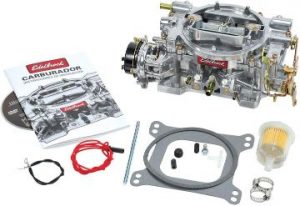
Best Overall
Edelbrock has been delivering high quality replacement auto parts since the 1930s, and has always had a reputation for striving for excellence. A significant change in February 2020 saw it join forces with the COMP Performance Group of Memphis Tennessee, and together, the companies have been developing and delivering industry-leading parts from their state-of-the-art facilities, including their own R&D department and two forges – one for permanent mold and one for aluminum sand casting.
The Edelbrock 1406 Performer 600 CFM Square Bore Carburetor puts its main venturi system on the bottom of the carburetor, creating lower pressure in the vales and pulling fuel through at a faster rate than other carburetors. Then a secondary air valve system adds even more pressure, sending strong signals to the intake manifolds.
With an electric choke that keeps drawing in charge while the ignition’s on, and cools down when the ignition is turned off, we found that the carburetor didn’t store up heat when we checked it.
The square bores on this carburetor mean that the bore and throttle values are exactly 1:1, giving the Edelbrock an impressive efficiency and quick acceleration of the engine from a low RPM during testing.
Compared to previous Edelbrock carburetors – and plenty on the market from other companies today, Edelbrock has added the ability to ‘hold a tune’ to the 1406, meaning once it’s tuned, it stays tuned. That in turn means it won’t be affected by engine blowback but will sing sweetly on.
Testing the 1406, the impression it gives is of consistency and calm. Easy to tune and unaffected by engine blowback, its venturi arrangement and pressure-based push of the fuel-air mix delivers rapid acceleration without the instability of some other carburettors.
Pros:- Innovative venturi arrangement delivers a fuel-mix under pressure for smooth distribution
- Holds a tune, for easy acceleration from low RPM
- The electric choke means the carburetor doesn’t build or store unnecessary heat
- The precision in this carburetor takes out some of the rawness beloved of some drivers
2. Jet 35002 Rochester Quadrajet Stage 2 Carburetor2. Holley 0-1850sa Aluminum Four-Barrel Street Carburetor
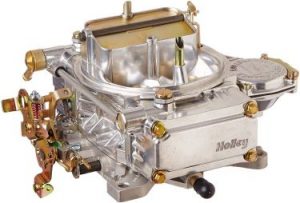
Best Runner-Up
Jet Performance Products is a company that went from hardcore racing roots in Southern California through specialization in carburetors for the likes of NASCAR, to electronic testing for major manufacturer. It knows how to make a carburetor that can deliver a potent mix to the intake manifold.
The Quadrajet carburetor from Jet is more than innovative, it actually helps maintain the health of the engine. Normally, we’d frown on keeping an engine idling, because it’s asking for damage to the spark plugs, the gas casket and other important parts of the engine.
The Quadrajet re-writes some of the rules on that in this iteration. We found that it lowered the combustion rate of the engine while it was idle, by pushing fuel through the idle ports instead of the main jet.
Lost? What it means is that you greatly reduce the risk of damage from an idling engine.
The dual plane intake manifold in this carburetor means a larger surface area and more efficient air transfer.
When we tested the Quadrajet, it inspired first bemusement, then a degree of tightly controlled awe when we realized it was lowering the combustion rate. With four barrels, the transition between running and idle states was smoothed, which makes it an extraordinary carburetor, which pairs well with the Chevy 350.
Pros:- Innovative techniques protect your engine while it’s idling
- Large surface area helps provide more efficient air transfer
- Four barrels smooth the transition between running and idle engine states
- Encourages engine-idling, without making it entirely safe
3. Holley 0-1850sa Aluminum Four-Barrel Street Carburetor
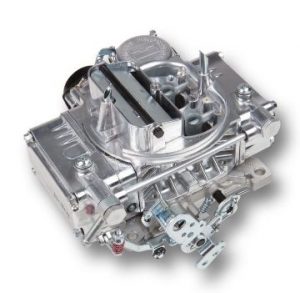
Best Budget Option
Holley has been driving the development of fuel-system technology for over a century.
In recent years, it has focused on producing market-leading EFI products and brands. It has also branched out into developing parts to boost late-model and vintage vehicle performance.
The Holley 0-1850sa Aluminum Four-Barrel Street Carburetor produced about 600 CFM during testing, which would make it a good match for cars that have had modifications. Relatively lightweight and shiny, it was kind to the engine we tested, and should continue that way going forward.
Usefully, the Four-Barrel has been calibrated to universal V8 engine standards, so it can be installed out of the box and runs fine so that it can be installed right away after the purchase.
There’s a manual choke on the Four-Barrel, meaning it has to be controlled by connecting cables. While that was troublesome to use, manual chokes can give the engine a jolt in the cold.
The Four-Barrel had vacuum secondaries, connected to a diaphragm attached to springs. That means when air passes through the diaphragm, the vacuum makes it gain rotational speed. That builds up force and opens up the spring, sending air to the venturi at high torque.
These vacuum secondary blades are an innovation in this version of the Four-Barrel, and outperform mechanical blades in heavier engines.
And following on the heels of the 1406, the Four-Barrel also guards against engine blowback.
During testing the manual choke was an issue, but overall, with the protection against blowback and the high-level calibration, the Holley 0-1850sa Aluminum Four-Barrel Street Carburetor felt like the best four-barrel carburetor we tried with the Chevy 350.
Pros:- Vacuum secondaries gave good rotational speed
- The Four-Barrel was calibrated to a universal V8, so it could be easily installed straight out of the box
- Protection against engine blowback gave a calm smoothness to its operation
- The manual choke, which does have its uses, was more trouble than it was worth in testing
4. Holley 0-80457S Model 4160 Square Flange 4-Barrel Vacuum Secondary Electric Choke Carburetor
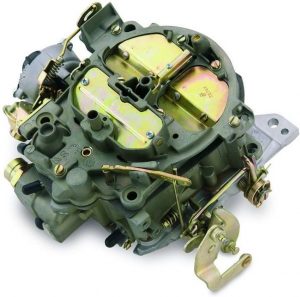
Best for modified engines.
Sticking with Holley, the company’s explorations recently into carburetors for late-model engines comes to the fore in the Square Flange.
If you’re upgrading your engine with modifications, our testing suggests this could be a carburetor of interest to you. Like the Four-Barrel, the Square-Flange comes out of the box calibrated for the V8.
Like the Four-barrel, there are 4 barrels in the Square Flange carburetor, and when we examined it, it fed a perfect mixture of fuel and air into the Chevy 350’s eight cylinders.
Where the Square Flange begins to pull away from the Four-Barrel is in the addition of an electric choke, which made the whole experience more reliable. Using a single fuel feeding inlet, the electric choke drew air into the system very smoothly, certainly compared to the manual version.
As with the Four-Barrel, the Square Flange brings secondary blades into play, which means the air enters the venturi easily by increasing the RPM of the flow. The Four-Barrel might well be the best carburetor on a budget, but this felt like a cut above in terms of operation with the Chevy 350.
Where the previous two carburetors gave an overall sense of calm when we tested them this model gave the feeling of having tapped hidden resources of power. That’s why it feels most appropriate for modified cars and engines.
Pros:
- Secondary blades increase the RPM of the flow, letting air into the venturi easily
- The addition of an electric choke might not be innovative, but it feels like it in the Holley range
- Gives more of a sense of power than some carburetors
Cons:
- If you’re not already modifying your engine or your car, this might feel overly aggressive
5. Holley Model 2300 350Cfm
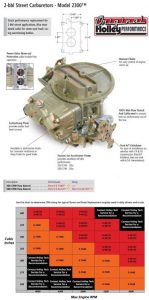
Best for engine mounting.
Holley, as we’ve seen, is a company that has been innovating repeatedly throughout its history, and has most recently had success with carburetors for unusual or less modern engines and vehicles.
That’s a line of research it brings fully to the fore in its 2300 carburetor. Significantly boosting power and performance, it uses a very straightforward ‘plug and play’ system to mount on top of the engine – which is why we’ve awarded it best for engine mounting. That plug and play aspect allows you to install it quickly and get on with the business of testing how much efficiency it adds to the V8 – which is a lot, based on our investigations.
There’s an elegance to this simple yet innovative mounting system that puts the 2300 above many previous versions – and some in this year’s carburetor crop. The ease of mounting in fact threatens to overwhelm the impact of the carburetor itself, like a gimmick which is certainly no gimmick.
With a 350 CFM, the 2300 can inject life into the Chevy 350, to the point where it could deliver street levels of performance, and even possibly work for racing on oval tracks.
One thing we noticed was a lack of any unwanted emissions while testing the 2300, despite delivering a highly efficient fuel-air mix. And while it doesn’t guard against engine blowout, there is a power valve inside the carburetor which will clearly deal with any blow outs that happen.
It’s true that this carburetor has a manual choke, and while that can make it more difficult to operate than it needs to be, it does come with the upside of being safe for winter use – it will let in the same air supply irrespective of temperature.
And it’s also worth mentioning that this carburetor came with a dichromate finish that should stop corrosion from ruining the effects of this highly inventive carburetor.
The experience of using the 2300 was more one of initial surprise than anything else, but when using it in a full set-up, what you’ll find is a feeling of a significant power increase due to the 350 CGM.
Pros:- A 350 CFM means the carburetor easily adds power to the engine
- The plug and play mounting system is inventive and makes for easy maintenance
- A switch can guard against engine blowout
- While it has its upsides, the manual choke is rarely as efficient as an electric one
6. Demon 1901 Electric Choke Polymer Street Demon Carburetor
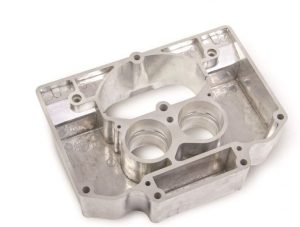
Best for the street.
Demon is a Holley product range with a little more street fire in its belly. As such, it’s been helping Holley build new adherents for a few years now, especially among street drivers.
The 1901 Street Demon takes the whole thing up a notch, from the thin film of aluminum on the outside to the single velocity stack in the air inlet, reducing turbulence in the induced air.
A composite fuel bowl feels like an innovation, and keeps the fuel cooler by 20 degrees Celsius, so as to optimize the fuel mixing process.
An electric choke system always jolts the engine into life – cold temperatures or not – and the response from the throttle has a street-appropriate growl. That’s down to the 1-⅜ inches of the primary throttle bores and the triple stack boosters, boosting the pressure drop through the main venturi.
The airflow is around 625 CFM, which gives the Chevy 350 something to get its teeth into.
Testing out the Demon, the word that sprang to mind was ‘Extra.’ It adds a little extra spin to every element of its construction and operation, and should give you and your Chevy 350 a buzz when it hits the streets.
Pros:- 625 CFM makes for a powerful carburetor
- This is very responsive to throttle commands
- The electric choke gives you reliable starts in all temperatures
- Feels and sounds very brash
7. New Carburetor For Type Rochester 2GC 2 Barrel Chevrolet Chevy Small Block Engines
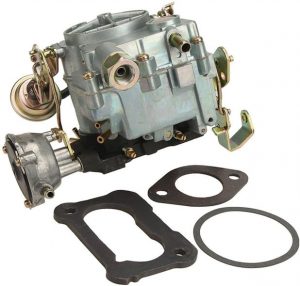
Best for fuel economy.
It’s worth acknowledging that Auto Parts Prodigy, the people behind this carburetor, have little by way of history or reputation to recommend them – certainly when compared to companies who’ve been innovating carburetors for 50 years or a century.
Nevertheless, there’s something about what we’re calling the Rochester 2GC that acts as a very attractive calling card – it will suck the last drops of fuel efficiency out of the Chevy 350’s potential and deliver them to you.
For all its fuel efficiency, this is a carburetor that has little truck with modern, lightweight molding – this is a heavy metal-bodied 2-barrel behemoth, but like the best bodybuilders, it knows how to work with what it’s got. If your Chevy’s struggling on hills, then as unlikely as it might initially seem, this could be the carburetor with your name on it.
Be aware though that this power-finding carburetor is an unorthodox shape, and is somewhat taller than a regular Quadrajet, so you’re going to need to check whether you can fit it under your hood before you… well, fit it under your hood.
It would be a mistake to oversell the Rochester 2GC as being especially innovative, or having hidden depths. There’s absolutely nothing hidden about the Rochester – it’s heavy, and awkward, and does not play well with all others if you actually try and use it in a car, rather than in a testing facility. But if you need to squeeze the last drops of performance and fuel efficiency out of your Chevy 350 – this could be the tool to do it with.
Pros:
- Incredible fuel efficiency from a heavy metal carburetor
- Sturdy design means once it’s in place, it won’t budge without you moving it
- Comes with its own mounting gasket
Cons:
- Its unusual height means you need to check whether you can use it in your car
8. Quick Fuel Brawler Street 650 Cfm Ms Silver/Black
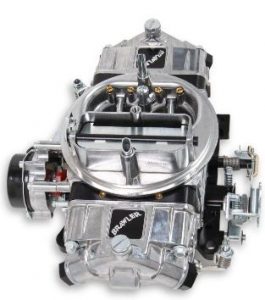
Best for racing.
Brawler is another Holley product line dedicated to bringing street drivers into the Holley carburetor fold.
As far as that mission goes, the Quick Fuel is an efficient soldier in the fight. With a 650 CFM, it’s a carburetor already customized for direct installation to your Chevy 350.
It has also been pre-calibrated for metering rods, which was a positive surprise when we tested it, and will probably have the same effect on those who buy it.
That hallmark of the Brawler carburetors is their precision control of the fuel-air mix, and are carbs that are especially designed to control precision in the air and fuel mixture. The Quick Fuel range has a solid reputation for being both reliable and budget-friendly.
Made from aluminium, the Quick Fuel sits easily between the engine and the airbox. Aluminum’s reputation for being both lightweight and strong helps make this a carburetor that is unthreatening to work with and test, but one that delivers the power through its mixture extremely efficiently.
Made entirely from brand new components, the Quick Fuel has an innovation that other carburetors have yet to match – you can get it in either a vacuum or a mechanical secondary model.
That 650 CFM will give you good service if you have a standard engine. But don’t try fitting this to an engine with power adders – you won’t get the response you were looking for.
It comes with 4 barrels, which gives you a good mixture of air and fuel, and the choke here is electric, for ease of regulation.
Testing the Quick Fuel Brawler gave us the impression of power that was of a lot of power in a strong, but extremely lightweight frame. That combination of light weight, streamlined air-fuel mixing, and 650 CFM is what made us award it best for racing.
Pros:
- 650 CFM will give you a good mixture and transferable power
- The aluminum carburetor is very lightweight
- Four barrels deliver an effective fuel-air mix
Cons:
- Not suitable for engines with power adders
9. Proform 67254 Street Upgrade Series 600 CFM Polished Aluminum Dual Inlet 4-Barrel Square Bore Mechanical Secondary Carburetor with Electric Choke
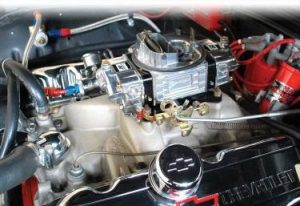
Best for light cars.
Proform, like Auto Parts Prodigy, has little in the way of reputation on which to trade, but the 67254 mechanical secondary carburetor should work well with lighter cars with manual transmission, large rotating cams and low rear end gears.
In testing, the Proform carburetor had a 600 CFM, which would be useful for a wide variety of cars, including both race cars and street cars. Certainly, it worked well with the Chevy 350. As with the Brawler though, this is not suitable for cars with power adders fitted. However, keep in mind that this carburetor is not ideal for cars that have power adders.
We observed impressive performance at all levels of RPM values with the Proform, which was down to the dual inlet system. Four barrels, along with the dual inlet manifold system, make the Proform especially suitable for vehicles with large displacement engines.
The 67254 is made from all-new parts, so it should have very few issues for a good length of time.
When testing, the 600 CFM felt impressive from a relative newcomer to the carburetor market.
Pros:
- 600 CFM should be useful on a wide variety of cars
- Impressive RPM performance, thanks to the dual inlet system
- All-new components should guard against corrosion
Cons:
- Little by way of reputation against which to judge the carburetor
10. Proform 650 CFM Square Bore Race Series 4-Barrel Carburetor P/N 67301
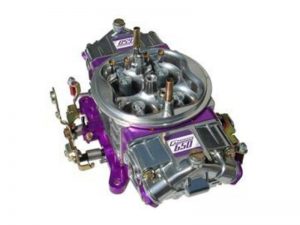
Best for high CFM.
Another Proform carburetor, this one with a 650 CFM, the 67301 has four barrels that should result in good performance in both race and street cars. The performance of the carburetor is optimized, depending on the range of the RPM.
The barrels in the 67301 are divided into primary and secondary barrels, so that when the RPM is low, only the primary barrels are used, meaning less air is allowed in and a better fuel-air mix is achieved for that low RPM level. More RPM opens the secondary barrels to add extra air into the mix, meaning it delivers a smooth acceleration process without unnecessary drama.
On a stock Chevy 350 engine, the 650 CFM worked well in testing, without needing (or at any rate, having) the bells and whistles of some carburetors with a better and longer pedigree.
Pros:
- 650 CFM should give a strong performance in both race and street cars
- Four barrels allow for a smooth acceleration
- A relatively straightforward, uncluttered carburetor
Cons:
- As with the 67254, Proform carburetors come with little company history to back up their products
Frequently Asked Questions About 350 Chevy Carburetor
-
What CFM is best for a Chevy 350?
Assuming the engine doesn’t have power adders deployed, 600 CFM is an optimal number. But if there are power adders like dual plane intake manifold systems, then 700 to 750 CFM is ideal.
-
Does a carburetor increase horsepower?
No, horsepower numbers are intrinsic to the engine. What it can do though is maximize the engine’s horsepower, so you get all it can give. That will feel like extra horsepower if you’re used to an inefficient carburetor set-up
-
How do I tell if the carburetor is not working properly?
A big clue is the engine’s cylinders not filling up all the way. If that happens, you’re going to need a bigger carburetor. An easy way to tell without diving under the hood is to try driving uphill. If your car struggles to accelerate, it could well be down to carburetor issues.
-
What is the best carb for a Chevy 350?
After testing some of the best on the market, we’d go with the Edelbrock 1406.
-
What is more dangerous, running rich or running lean?
Both. Running rich will give you engine trouble and impaired acceleration. Running lean could dry out (and blow up!) your engine. On balance, you’re slightly safer running rich.
Leave a Reply